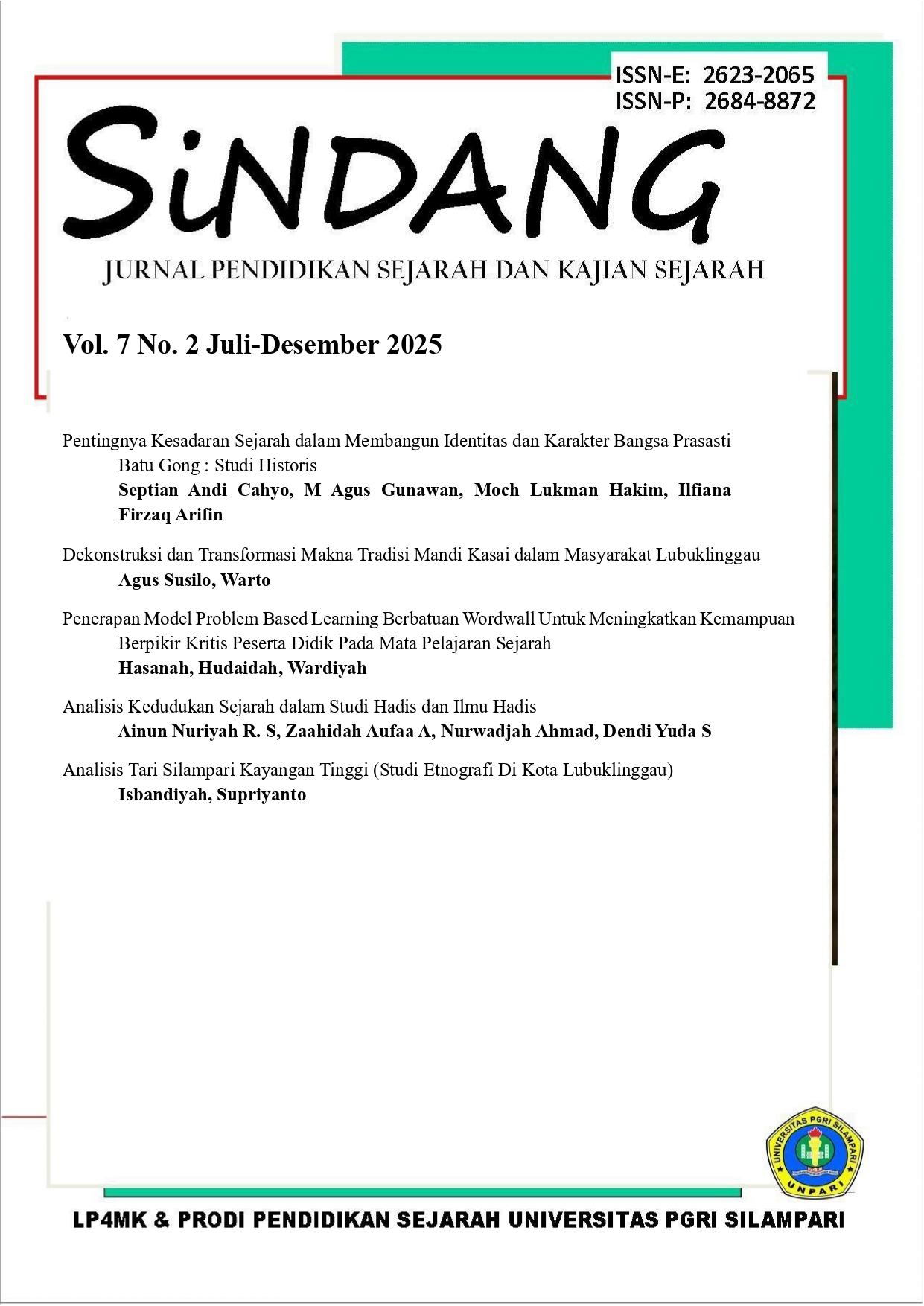Prasasti Batu Gong : Studi Historis Peninggalan Sejarah Lokal Jember yang Terbengkalai
Abstract
Local history is a branch of history that is interesting to discuss the culture or history of a region. One of Jember's local historical relics is the stone gong inscription. The Batu Gong Inscription is located in Kaliputh, Rambipuji District. This inscription is thought to have existed since the 7th – 8th century AD. This inscription was discovered by Dutch archaeologist W.F. Stutterheim and H.R. Heekeren in 1933. The aim of this research is to analyze the various factors that caused this inscription to receive less attention and outline the historical context of the Batu Gong inscription in the development of local Jember history which reflects the culture and traditions of the community at that time. This research uses literature, observation and interview methods. Factors in which the stone gong inscriptions have been neglected are lack of attention from the government and society, lack of promotion and education, as well as lack of coordination and governance. It can be seen from the literature that the role of government and society is very necessary. The government can be a motivator, facilitator and dynamist in preserving the Batu Gong Inscription.
References
Aneka ragam khasanah budaya Nusantara. (1997). Indonesia: Departemen Pendidikan dan Kebudayaan.
Cahyono, M. D. (2013). Wanwacarita: kesejarahan desa-desa kuno di Kota Malang. Indonesia: Dinas Kebudayaan dan Pariwisata Kota Malang.
Ekarini, F. D. (2015). Perizinan dalam Pelestarian Cagar Budaya. Jurnal Konservasi Cagar Budaya, 9(1), 29-48.
Farhan, Y. (2017). Masa Lalu Jember: Studi Historis Peradaban Jember Pada Masa Majapahit. Indonesia: Pustaka Abadi.
Hariyadi, E., Saputra, H. S., Maslikatin, T., Siswanto, S., Rato, D., Ilham, M., & Yuliati, L. (2023). Kemah di tanah leluhur: Pendampingan branding wisata megalitikum Desa Kamal, Jember. Community Development Journal: Jurnal Pengabdian Masyarakat, 4(5), 11083-11096.
Hartati, U. (2020). Cagar Budaya Sebagai Sumber Belajar Sejarah Lokal. Diakronika, 20(2), 143-151.
Kinanti, L. A. B, N. A Rahman, dan A. Supriadi. 2018. Upaya Penyelamatan Benda Purbakala Sebagai Wisata Edukasi. UNEJ e-Proceeding, 624-632.
Kompasiana, Wisata Sejarah Gumuk Gong (Watu Gong) Desa Rambipuji, 5 September 2019,[18 Juni 2024],
Mareta, Y., & Jamil, R. N. (2022). Pembelajaran Sejarah Lokal: Enkulturasi Berpikir Kritis. Tarikhuna: Journal of History and History Education, 4(1), 1-11.
Permatasari, I., Firnanda, I., Dharmawan, A. L. K., & Suhma, W. K. (2024). Efek Implementasi Revitalisasi Situs Bersejarah Kabupaten Jember Terhadap Perekonomian Masyarakat. Gudang Jurnal Multidisiplin Ilmu, 2(2), 277-280.
Suhalik, A. (2020). Benang Merah Peradaban Blambangan.
Sukatno O, C.R, dan U. Mulyono. 2018. Kitab Para Raja; Menguak Jejak Genealogi Sejarah Wangsa Jawa dari Tarumanegara Hingga Majapahit. Bandung : Nusamedia
Sukatman, S., & Siswanto, S. (2016). Alternatif Solusi Konflik Separatisme dalam Cerita “Calon Arang”. ATAVISME, 19(1), 116-129.
Sukmana, W. J. (2021). Metode penelitian sejarah. Seri Publikasi Pembelajaran, 1(2), 1-4.
Suryadi, A. (2010). Sejarah Nusantara: Dari Kerajaan Hingga Negara Modern. Jakarta: Balai Pustaka.
Thohir, A. dan A. Sahidin. 2019. Filsafat sejarah : Profetik, Spekulatif, dan Kritis. Jakarta : Prenada Media.
Widuatie, R. E. (2020). Tradisi Lisan sebagai Penguat Identitas Kebangsaan: Studi terhadap Tradisi Lisan Terbentuknya Desa di Kabupaten Jember. UNEJ e-Proceeding, 519-528.
Zainollah dan B. Sutedjo. 2015. Prasasti
Batu Gong Rambipuji dalam Telaah Historis. Forkom Bhattara Saptaprabhu. https://saptaprabhu.blogspot.com/2015/03/prasasti-batu-gong-rambipuji-dalam.html

















